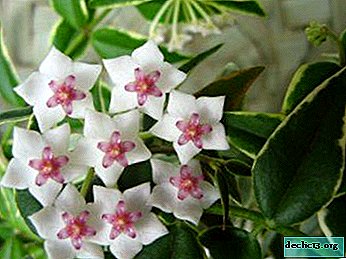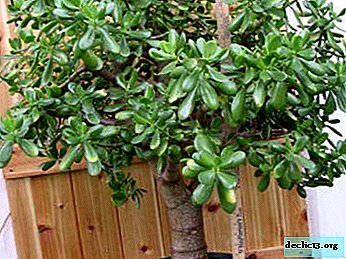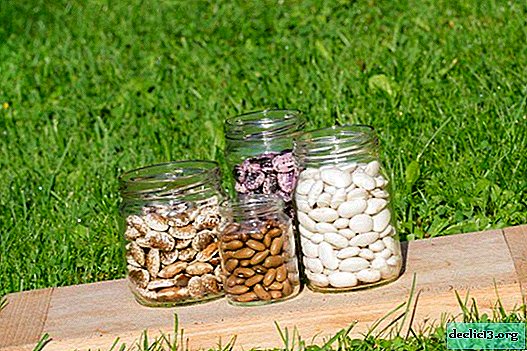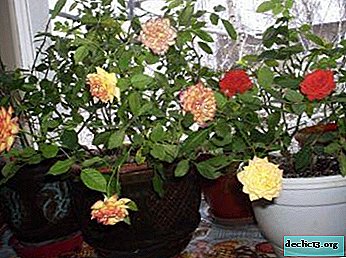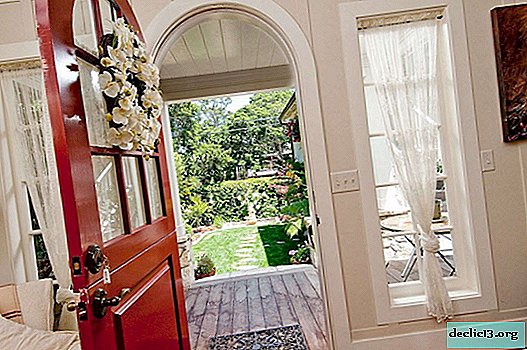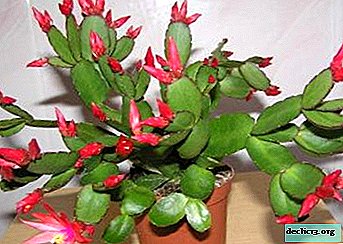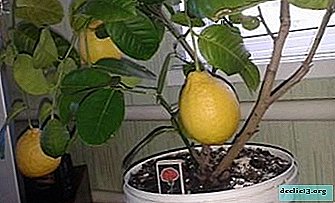Overview of lemon varieties for home growing. General principles of care
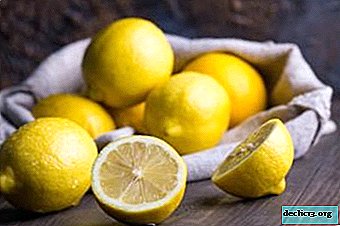 About lemon, as a fairly specific fruit, you can talk for a long time.
About lemon, as a fairly specific fruit, you can talk for a long time.
It is included in many dishes, it is used in the treatment of various diseases, to enhance immunity, during cosmetic procedures, even in everyday life you can find a use for it.
And, of course, the external beauty of many causes a desire to bring this specific culture to home.
It is difficult to do this or not - let's find out from the article below.
Description and photo of varieties of fruit for home growing
Consider a brief description of lemon varieties for home growing. You can also see photos of each variety of decorative fruit.
Pavlovsky
This variety rarely grows more than a meter in height, but differs in compactness and strong roots. Leaf blades are large, shiny, light green, with notches at their tips. Petioles are short, without lionfish.
It can bloom 3-4 times a year, especially violently in the early autumn and early spring (7-10 days). The direct sun categorically does not like.An adult mature plant gives up to fifty fruits per harvest. Lemons are bright, with a thin peel, they are distinguished by a delicate refined aroma and taste.

The video tells more information about lemon Pavlovsky:
Ural
In many ways it is similar to Pavlovsky variety - the same strong and lush cap of foliage. The leaves are elongated, with noticeable veins and wavy edges, grow opposite to each other. Resilient to temperature changes, it grows well in both cool and warm rooms.

Maykop
This variety has not gained worldwide fame, but in popularity among citrus lovers it is in one of the first places, as it is well adapted to the conditions of the apartment, it easily withstands both a lack of light and dry air. Exists perfectly in tubs.
There are two types of Maykop lemons:
- The first is a standard tree with a symmetrical crown, reaching a height of 2 meters.
- The latter grow exclusively as bushes that do not have thorns.
The fruits of the Maikop variety are dark green, with a dense, wax-like skin. Fruits in 15-20 years (annually gives the owner from 150 to 300 fruits).

Find out more about Maikop lemon:
Novogruzinskiy
The second name of the variety is New Athos. It was first bred by breeder Murri in Sukhumi, at the local experimental station. It differs in quite large dimensions. and in height can reach 2 meters. Its leaves are large, but graceful, elongated and shiny.
Flowers also attract the eye: large, with light purple petals that emit a delicate aroma. A year can produce several tens of fruits (oval, weighing up to 120 g).
During the growing season they are able to bloom 3 times. The flowers are medium in size, smell pleasantly, painted in light purple shades, but you will not be able to admire them immediately, but only after 4-5 years after rooting. The fruits are oval, light, with a light yellow skin and a bright aroma, suitable for long transportation. It is superior in taste to other varieties. Requires frequent trimming and molding.

Below is a video about Novogruzinsky lemon:
Genoa
Until recently, this variety could only be found among the most devoted collectors - Genoa is very capricious and picky about leaving. The bush grows compact, medium height, the branches are covered with thick dark green leaves. The shape of the leaf plates is ovoid, oval, with pointed tips.
It begins to bloom at the age of 4-5 years, and several times during the season. Differs in productivity - from one tree you can collect about two hundred fruits. The peel is not bitter, therefore, unlike the fruits of other varieties, it can be eaten.
Genoa is excellent for breeding a house, but for larger purposes it is difficult to use: commercial value is reduced, firstly, by poor detachability of the peel, and secondly, a large number of dense films inside.

Lisbon
A common industrial culture, but also in private collections is common. His historical homeland is Portugal. This variety is one of the most resistant to low temperatures and drought. It is grown on an industrial scale, as it gives large yields and has high transportability. Outwardly, it looks like a powerful tree with a lush "cap" of leaves.
There are many small brown spines on the branches, the leaves are lanceolate, dense, with pointed tips. Blossoms in the 3rd year of life with small inflorescences. It emits a strong but pleasant smell of citrus. Fruits are juicy, soft, seeds are practically absent
The fruits of the Lisbon variety are easy to distinguish from others: by curving the tubercle from one tip. It is as if pressed inward and oily to the touch.

Anniversary
It does not pamper in height (reaches only 1.5 meters), but grows strong and durable. Leaves of a saturated green shade, numerous, sit on short petioles. It blooms profusely with large white-pink buds, and manages to do this several times a year.
The first fruits may occur already in the second year after rooting. Productivity is high, it does not fall in the conditions of the greenhouse, and in an apartment with dry air. It is steady against a lack of light.

Learn more about Yubileiny Lemon from the video:
Irkutsk large-fruited
A medium-sized variety with large leaves and large white flowers, collected in a brush. It blooms in spring and autumn. The first fruits can be expected already in the second year of the plant's life. It grows well in the house (on the sunny side), is not picky and forgives the flaws of care. Lemons, on average, weigh 500-700 g, but sometimes real giants are also noted - up to 1.5 kg! The peel is dense, bumpy, matte.

New Zealand
In conditions close to natural, it stretches up (up to 3-4 meters), while the room does not exceed 1.5 meters. The leaf plates are wide, with small denticles on the edges and a sharp tip. They produce a sharp but pleasant smell, so this variety is easy to guess even from a distance.
Outwardly resembles citron - and strong shoots, and lionfish, and the ability to withstand low temperatures (up to - 5 degrees) in open ground. The flowers are very elegant: with thin, curved petals, painted on the outside in all shades of purple and blue, and inside - milky white. Grow in inflorescences of 2-3 pieces.
The largest fruits of all known (the smallest weigh 700-800 g). The commercial value of the fruit is low: the taste is specific, the grayish-colored flesh is poorly peeled, so this variety is recommended to be grown as a decorative ornament.

Panderosis
The result of crossing citron and lemon. It differs from the rest by early and magnificent flowering. Grows in the form of a bush, lush, with sprawling and strong branches. The leaves are shiny, emerald, concave. The fruits are shaped like pears, with a dense and tuberous skin.

The video provides more information about Panderosa lemon:
Villa Franca
A plant with powerful branches and a spreading crown, able to withstand both heat and drought, however, it requires a lot of light. It begins to bear fruit in the second year after rooting, however, it cannot boast of large fruit sizes - the weight of one lemon is 100-150 g. The skin is dense, smooth, glossy. The pulp tastes sweet and aromatic.

The commune
He was brought to Russia from Italy and gained some fame. Grows in the form of a tree. Branches are well leafy, spines are present, but in small numbers. High yields oval fruits with juicy sour flesh and almost no seeds.

Kursk
This variety has such a sprawling and lush crown that without regular pruning, the plant will no longer fit on the windowsill, for example, and it will have to look for a more spacious place to exist. Derived from the Novogruzinsky variety, from whom it adopted its main characteristics: elongated dark leaves with wavy edges, resistance to lack of light and moisture.
Able to survive and when the temperature drops to - 4, but short-term. The flowers are large, snow-white, appear twice a year: in September and early spring. Fruits yield a moderate amount, the average weight of an instance is 200-250 g.

Tashkent
Due to its similarity to Meyer, this variety is sometimes difficult to distinguish even for an experienced breeder. Under the conditions of the apartment, it hardly reaches one and a half meters, in the greenhouses it adds a maximum of a meter. Crohn is neat and does not require special attention. The branches are dense, wide, grow to the trunk almost at right angles. Bark of olive shade. The leaves are narrow, thin, uneven.
The flowers are collected in inflorescences, have a pinkish color and a pungent lemon smell. They appear both in autumn and spring, self-pollinating. The fruits are small and taste like oranges, with juicy orange flesh.

Moscow
Clone of Novogruzinsk variety. Its leaves are leathery and fleshy, reaching a length of 20 cm, with a faint odor. There are almost no thorns, the stem is branched. The flowers are small, white.

Mezensky
Exclusively decorative variety - the fruits taste bitterly acidic and cannot be used as food. But outwardly it is a fairly attractive medium-sized tree with a wide crown (which, if not cut in time, will grow unnecessarily). The leaves are wide and dense, inflorescences are small and bright purple, the smell is weak. The trunk and branches are covered with many thorns.

Lunario and other possible species
When choosing a variety, be guided by the following advice:
- In the northern regions, the varieties Pavlovsky, Kursky, Lunario, Ponderoza are best established.
- In the south - Meyer, Lisbon, Genoa, Maykop.
General principles of home care
All types of decorative lemons are difficult to tolerate acclimatization and a change of place, so it is important to initially provide him with comfortable conditions and proper care at home.
- Lemons do not like direct sunlight, so shade the window with a screen or curtains. The south window is ideal; in the north, your pet will most likely not grow at all.
- Be sure to buy a lamp - without exposure your plant will wither.
- Drainage layer - at least 5 cm. For this, ash or coarse sand burned in the oven is suitable.
- Soil: turf land, washed river sand and humus (in equal parts). Pick up the pot from burnt clay, be sure to put a couple of shards on the bottom, covering one of the drainage holes (this will help to improve the outflow of water and allow air to flow inside without problems).
- You can water lemons only with settled filtered waterheated to 33-35 degrees. In winter - 1-2 times a week (if the room is cold - 1-2 times a month), in the summer - more often, as the earthen coma dries up (every other day).
- Fertilizers need to be applied regularlyunder the roots.
- Transplant indoor lemon - every year for a young plant and every 5 years for an adult.
Learn more about lemon care from the video:
When choosing a cultivar for cultivation, consider not only the general descriptions of crops, but also the feedback of experienced gardeners. Feasting on lemon grown with your own hands is a tempting prospect, but remember the importance of vigilant control and careful care. If you can’t create ideal conditions for the plant, you will be disappointed. But nobody is forbidden to try. Take a chance and let luck be on your side!

